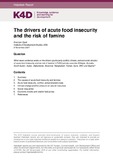| dc.contributor.author | Quak, Evert-jan | |
| dc.date.accessioned | 2021-11-19T11:56:53Z | |
| dc.date.available | 2021-11-19T11:56:53Z | |
| dc.date.issued | 2021-11-09 | |
| dc.identifier.citation | Quak, E. (2021). The drivers of acute food insecurity and the risk of famine. K4D Helpdesk Report no.1057. Brighton, UK: Institute of Development Studies, DOI: 10.19088/K4D.2021.132 | en |
| dc.identifier.uri | https://opendocs.ids.ac.uk/opendocs/handle/20.500.12413/16950 | |
| dc.description.abstract | This rapid review synthesises the literature from academic, policy, and knowledge institution sources on the drivers of acute food insecurity and famines with a focus on key FCDO-partner countries. This review builds further on evidence already collected in other K4D helpdesk reports.
The main conclusion of this rapid review is that the drivers of acute food insecurity are complex, often involving multiple and interrelated factors. The drivers for chronical food insecurity and acute food insecurity cannot be separated entirely from each other, as the evidence shows that slow-onset determinants of food insecurity could play a critical role during an event (or multiple events) that could trigger a food emergency. The literature shows that the political economy (e.g. food system governance or preparedness of institutions to disasters) and socioeconomic dynamics (e.g. shaping demand and supply of food) have become more relevant factors in any analysis on the drivers of acute food insecurity, acute malnutrition, and famine. This coincides with a shift in the literature away from global drivers of food insecurity and malnutrition toward localised dynamics on the national and sub-national level.
The analytical framework of Howe (2018) that captures this complexity distinguishes pressure, hold, and self-reinforcing dynamics as key dimensions that explain potential pathways for famine. These could be political-induced, natural-induced, economical-induced, or socially induced, but most often a combination. Based on this framework and supported by the evidence from the literature, this rapid review assesses conflicts and protracted crises; climate change and pressure on natural resources; social inequalities; and economic shocks and food prices, as the key drivers of acute food insecurity and famine. Importantly, from the literature it seems clear that acute food insecurity is the result of changing vulnerabilities that link with different coping mechanisms of households and communities. | en |
| dc.description.sponsorship | FCDO (Foreign, Commonwealth and Development Office) | en |
| dc.language.iso | en | en |
| dc.publisher | Institute of Development Studies | en |
| dc.relation.ispartofseries | K4D Helpdesk Report;1057 | |
| dc.rights.uri | https://www.nationalarchives.gov.uk/doc/open-government-licence/version/3/ | en |
| dc.subject | Agriculture | en |
| dc.subject | Nutrition | en |
| dc.subject | Rural Development | en |
| dc.title | The Drivers of Acute Food Insecurity and the Risk of Famine | en |
| dc.type | Helpdesk | en |
| dc.rights.holder | © Crown copyright 2021 | en |
| dc.identifier.doi | 10.19088/K4D.2021.132 | |
| rioxxterms.funder | Default funder | en |
| rioxxterms.identifier.project | K4D | en |
| rioxxterms.version | VoR | en |
| rioxxterms.versionofrecord | 10.19088/K4D.2021.132 | en |
| rioxxterms.funder.project | 0986883a-6d0f-4bb8-9c46-5e0682934d65 | en |

